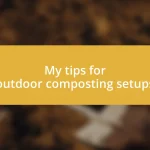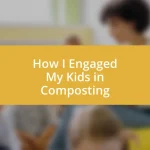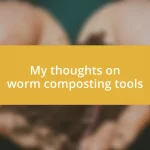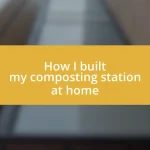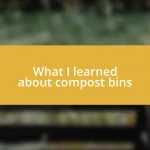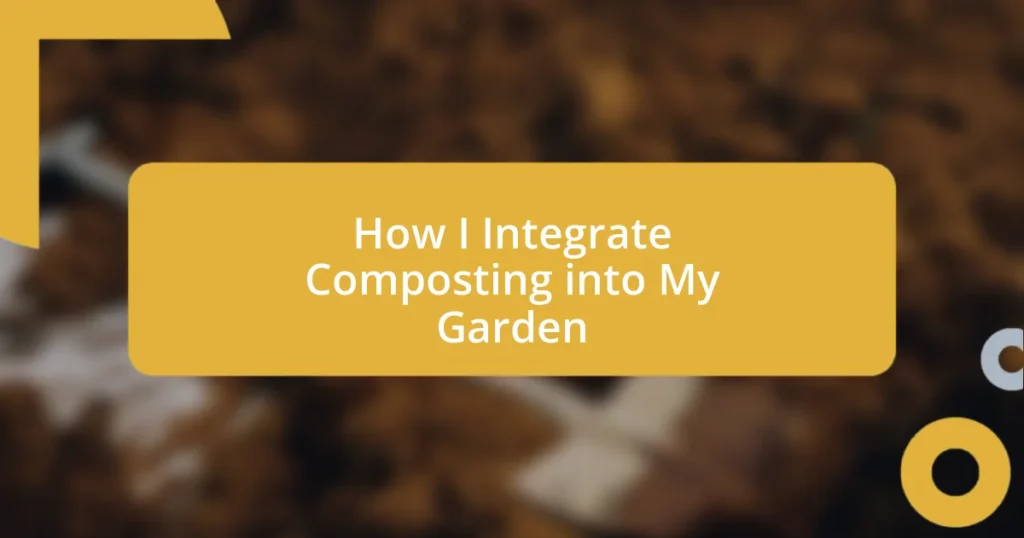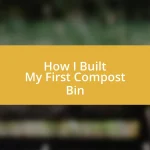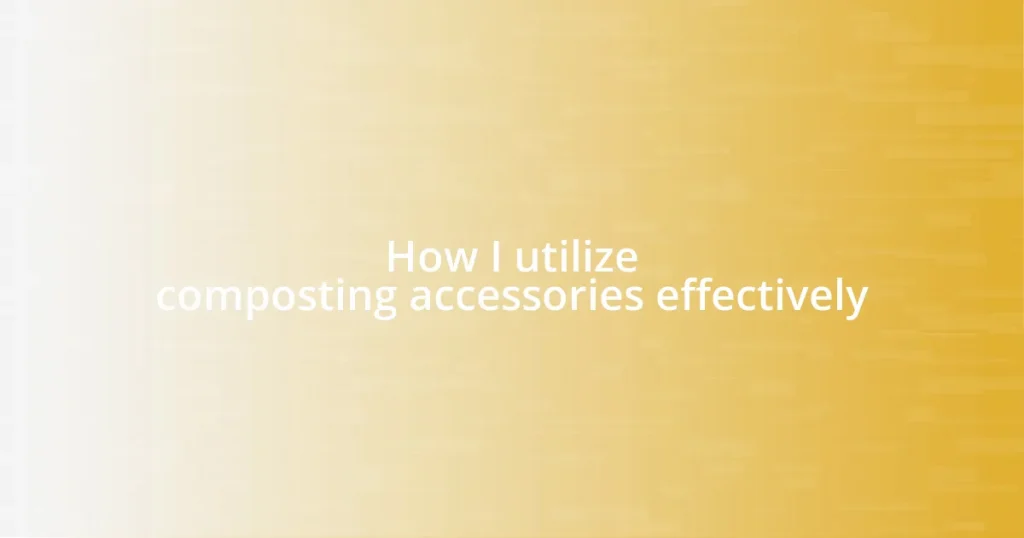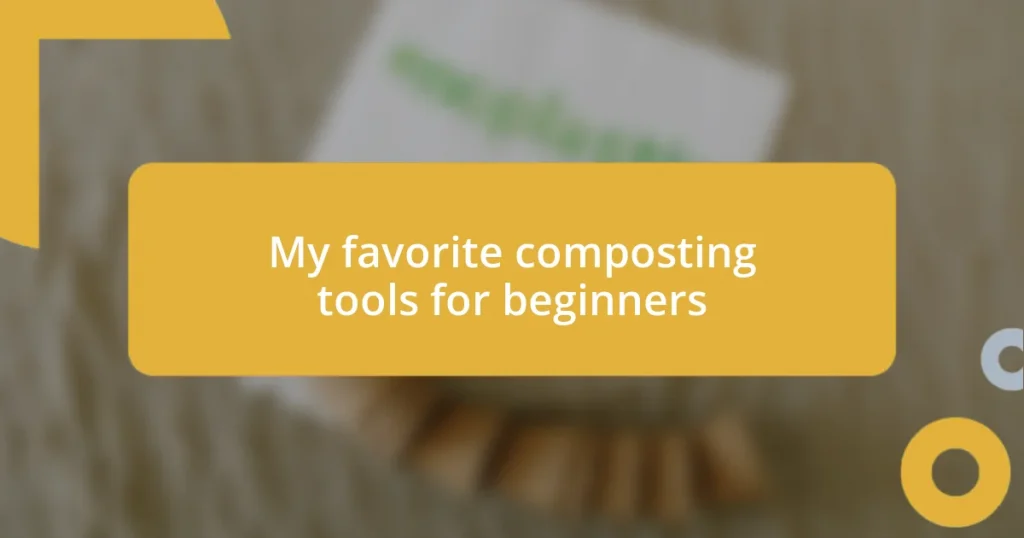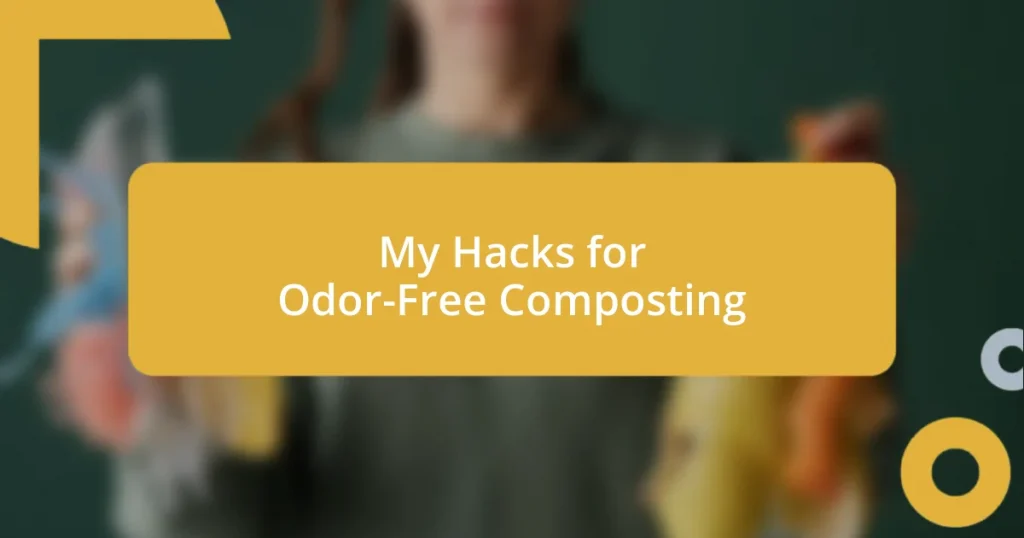Key takeaways:
- Composting enriches soil, reduces waste, and helps retain moisture, resulting in healthier plants and a positive environmental impact.
- Choosing the right balance of green and brown materials enhances compost quality, and proper preparation accelerates decomposition.
- Incorporating compost into planting beds boosts plant growth and flavor, with specific herbs and vegetables particularly benefiting from it.

Understanding composting benefits
One of the most significant benefits of composting is that it enriches the soil in my garden. I remember the first time I added homemade compost to my vegetable beds—I was amazed at how vibrant the plants became. Isn’t it incredible how something as simple as kitchen scraps can transform into such nutrient-rich gold for our gardens?
Composting also plays a vital role in reducing waste. When I realized that about 30% of what I tossed in the trash could actually be composted, I felt a mix of guilt and motivation. By composting, I’m not just improving my garden; I’m actively contributing to reducing landfill waste. Isn’t it rewarding to know that you’re making a positive impact on the environment in such a straightforward way?
Moreover, composting helps retain moisture in the soil, which has been a game changer during dry spells. Last summer, with the heat waves rolling in, my plants thrived because the compost helped keep the soil damp longer. It’s hard not to feel a sense of pride when you see the fruits of your labor flourish, all thanks to the way composting enhances the earth where your plants grow.

Choosing the right compost materials
Choosing the right compost materials can truly enhance the quality of your compost pile. I’ve learned that balancing green materials, like kitchen scraps, with brown materials, such as dried leaves or cardboard, is essential. One day, I was short on browns, and my compost turned a bit too slimy—an experience that pushed me to pay closer attention to those ratios.
When it comes to selecting materials, I ask myself if they’re biodegradable and nutrient-rich. I remember a time when I accidentally added a few citrus peels, thinking they’d add a nice zesty touch. However, I found out later that citrus can slow down decomposition. It’s funny how one misstep can teach you so much in gardening!
It’s important to consider the size of your compost materials, too. Chopping up larger items can speed up the breakdown process. I’ve seen this firsthand—my shredded cardboard breaks down significantly faster than large pieces would. So, what I’ve realized is that thoughtful selection and prep of your compost materials can make all the difference in creating that magical blend for your garden.
| Green Materials | Brown Materials |
|---|---|
| Fruit and vegetable scraps | Dried leaves |
| Coffee grounds | Cardboard |
| Grass clippings | Wood chips |

Setting up a composting system
Setting up a composting system may seem daunting, but I’ve found that with a little planning, it becomes a rewarding part of my gardening routine. When I decided to start composting, I chose a sunny spot in my yard that was easily accessible. This not only encouraged microbial activity but also made it easier to toss in kitchen scraps after meals. I felt like I was creating a mini ecosystem right in my backyard.
Here are some essential steps to consider:
- Choose a Bin: I started with a simple compost bin, which was budget-friendly and compact. This approach helped me manage the process easier.
- Select a Location: Opt for a spot that’s convenient but also has good air circulation and sunlight.
- Layering: I always remember to alternate between green and brown materials. This method keeps the compost balanced and smelly odors at bay.
- Monitor Moisture: It really helps to check if the mixture feels like a damp sponge. One time I over-watered and learned to keep things just right!
- Turn Regularly: Turning the compost weekly helps aerate the mix, speeding up decomposition. I make it part of my weekend routine, and it’s quite satisfying to see the transformation unfold.
Starting my composting system felt like embarking on a new adventure. Each time I added scraps, it was like sending a piece of my kitchen on an exciting journey to become something new and fruitful.

Maintaining your compost pile
Maintaining your compost pile is an ongoing journey. I find that the key is to stay engaged with the process. After I turned my pile for the first time and contributed to the delightful earthy smell, I realized that maintaining the right balance of moisture and air is crucial. If you’ve ever had your compost smell overpoweringly bitter, you know what I mean!
Regularly turning your compost not only speeds up decomposition but also gives you a chance to check in on your mix. I remember the thrill of finding worms wiggling around—such a testament to the life thriving within! Every week, I make it a point to aerate my compost, which feels like giving a little love back to the soil. How often do you check your pile? It’s a small commitment that yields big rewards.
Keeping an eye on temperature is also vital. When I first started, the excitement led me to simply toss in materials without much thought. I soon discovered that a properly maintained heap can reach impressive temperatures, helping to kill off any pests or pathogens. When I first felt the warmth radiating from my compost, it was a little victory that fueled my passion for gardening even more. Isn’t that a great feeling?

Incorporating compost into your garden
Incorporating compost into your garden is like giving your plants a nutrient-rich hug. When I first added compost to my flower beds, I felt a twinge of excitement watching the transformation unfold. I often mix it into the soil at the beginning of the planting season, and the results are usually astonishing—vibrant blooms and an abundance of vegetables. Have you noticed how plants react when they’re nurtured with care?
When I create new beds, I always start with a generous layer of compost. It provides that essential foundation for healthy growth. The first time I did this, I was amazed at how the moisture-retaining properties of the compost truly helped my plants survive during a dry spell. The garden became a thriving ecosystem, and it felt deeply satisfying to know I played a part in that. Isn’t it wonderful how nature rewards our efforts?
As the growing season progresses, I make a habit of top-dressing my established plants with compost. Just at the moment when the energy of summer starts to wane, I sprinkle compost around my plants. It feels like a boost, re-energizing them and extending their growth. In fact, seeing the difference it makes inspires me to continue nurturing my garden. Doesn’t every gardener want to make every season its best?

Using compost for specific plants
When it comes to using compost for specific plants, I’ve learned that certain herbs thrive exceptionally well with it. For instance, when I mixed compost directly into the soil for my basil, the plants seemed to radiate happiness. This aromatic herb tends to soak up nutrients, and I can’t help but feel a bit proud watching those verdant leaves flourish!
I’ve also observed that leafy vegetables, like spinach and lettuce, respond beautifully to a good compost top-dressing. The first time I tried this technique, it was almost magical—my plants grew not only bigger but also tastier, enhancing our salads in ways I hadn’t anticipated. Have you ever tasted a homegrown salad that just bursts with flavor? It’s hard to go back to store-bought after that experience!
Root vegetables like carrots and radishes are another story. Initially, I was hesitant to mix compost directly into the planting hole for these crops, fearing it might affect their growth. However, when I finally tried it, my harvest was nothing short of impressive. I couldn’t believe how much more vibrant the colors and flavors were! Now, I encourage everyone to experiment a little—sometimes it’s those risks that yield the most delightful surprises in the garden.



